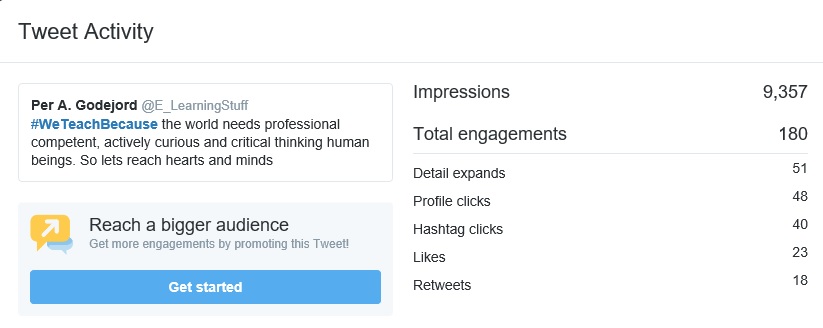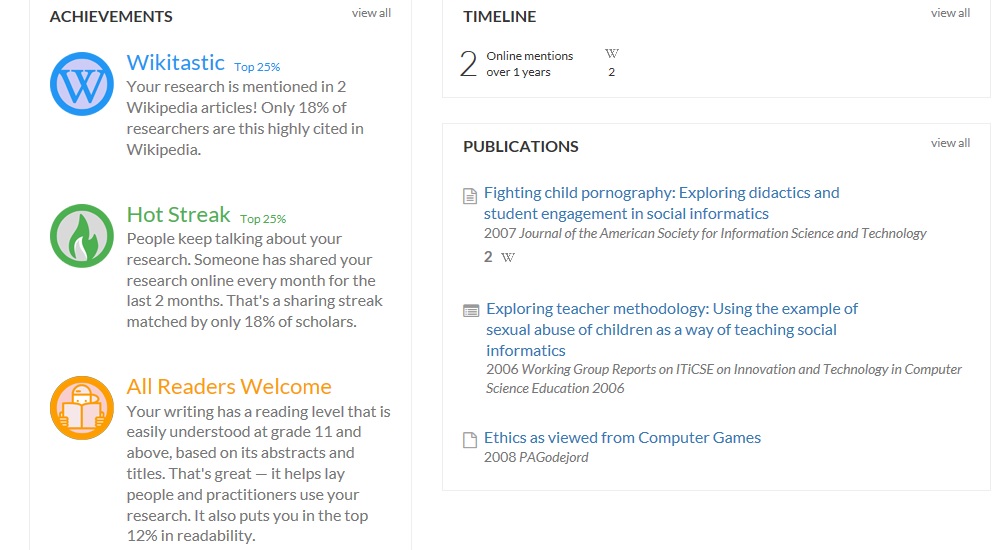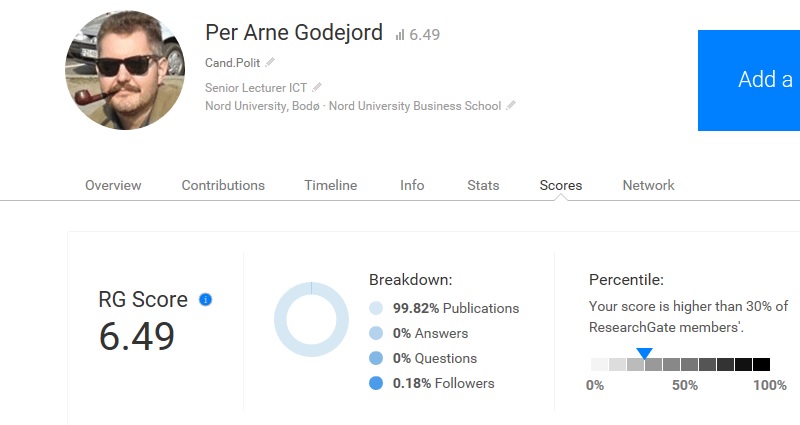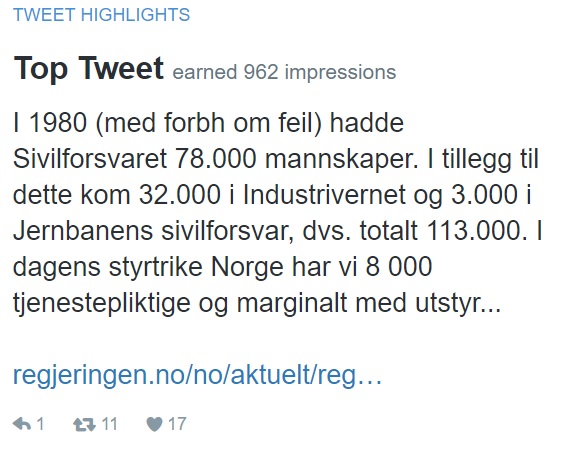…not everything that can be counted counts, and not everything that counts can be counted.
– William Bruce Cameron, 1963
Climbing the Social Media Pole
I’ve been fooling around on Internet since 1994 and most of the time in a professional capacity. Seriously influenced by people like Howard Rheingold, and curiously exploring the various possibilities for academic use of WWW, I’ve built quite a presence online over the years using every Social Media (or Web 2.0 as it was once called) tool as soon as it appeared. But as everyone that have been active users of Internet know, keeping track of multiple profiles, and keeping them alive and updated, is exhaustingly time consuming. At a certain moment, I reached a point where I felt nauseated and tired of everything connected with the Net and withdrew from almost all online tools.
But it is not easy to keep completely away from social media. As a conscripted officer in the Norwegian Civil Defence with staff duties, Facebook was the main source of information on what went on within my Civil Defence district. And truth be told; I also missed the online contact with my old team mates from the Home Guard School and Training Centre. So back I went, creating a new profile. As a dean, I had some lecturing so Twitter became, again, a useful tool. But that was it, I thought. No more profiles on the Net.
And then I went back to full time lecturing and everything changed. Because now, having papers publicised in international peer reviewed journals is no longer enough. Our university managers, as well as our lords and masters from the Ministry of Education, speaks of reaching out to a broader audience and that as much as possible of our work are to be open access. And suddenly one is urged to go back on the Net and immerse one selves in various online services.
The tools and all the work that follows
There are infinite possibilities of reaching far and wide using various social media services, and let’s face it; it is difficult to reach out to a large audience from a scientific journal. Not only are these journals mostly read only by our colleagues, but the possibility of having our journal entries cited by fellow researchers are slim. Not because we necessarily write badly or that our work is uninteresting, but because so many of us works within small niches. I have my selves spent most of my academic career pondering how to get computer science students enthusiastic about Social Informatics, or how to motivate students of asynchronously online courses to carry on. While this is important enough for me, and hopefully also for my students, it is neither rocket science nor is it the most popular scientific field in the world. But will enrolling in various Social Media services help you to reach out to a larger audience? Not necessarily.
Let’s have a look at some of the things you might do to be visible as an academic online. Many university managers will point you in the direction of ResearchGate.net and Google Scholar. The last one in order to create an overview of where and how often your papers are cited by others, and the first one because… well, I guess because “everyone else” is there and this is the only academic profiling tool they know of (a part from Google Scholar). So, by creating profiles on these two services, all your troubles are over right? Wrong! To utilise both Google Scholar and ResearchGate demands quite an effort. Like most social media profiles, they need constant updating to stay interesting and/or correct as for your list of publications, and preferably they should be paired with other tools like Twitter, ORCID, Impactstory, Mendeley, Web of Science and Quora. This will increase your online presence and could work favourably as for your so called “impact score”.
ResearchGate have developed into a well-known social networking site for researchers, where they may share papers, ask and answer questions, and find collaborators. In order to use the site, you need to have an email address at a recognized institution or to be manually confirmed as a published researcher in order to get an account. After signing up you create your user profile and might start uploading research papers, data, chapters, presentations, etc. You may also follow the activities of other users and engage in discussions with them, and this way start building a network and perhaps even enter into research cooperation with one or more of your contacts.
Impactstory is an open source, non-profit and web-based tool that provides altmetrics to help researchers measure the impacts of all their research outputs—from traditional ones such as journal articles, to alternative research outputs such as blog posts, datasets, and software. You may use your Twitter account to sign up, but how much this site uses your Twitter activity to measure your impact score is unclear to me. Signing up to Impactstory quicly pushes you to ORCID, as this is the key tool Impactstory uses to gain an overview of your publications. According to ORCID its aim is to aid «the transition from science to e-Science, wherein scholarly publications can be mined to spot links and ideas hidden in the ever-growing volume of scholarly literature». They also give the researcher a possibility to have «a constantly updated ‘digital curriculum vitae’ providing a picture of his or her contributions to science going far beyond the simple publication list».
Mendeley is a desktop and web program produced by Elsevier for managing and sharing research papers, discovering research data and collaborating online, and Twitter I guess does not need much of an introduction. To use Twitter as a dissemination tool you must have followers, preferably many. Your follower count is considered a measure of your influence. The more followers you have, the more you’ll attract, and – in theory – the more you can use your influence to reach your peers, students and other interested parties. But to get followers you have to put in a lot of time of strategic actions, and at the end of the day you might not really know if any of this had any effect or mattered at all. There are no free lunches in the world of Social Media, and just creating some profiles and then sit back and relax is not really an option.
Since all this is mainly about creating and measuring “impact”, utilising digital tools, the more activity you have online, the better. But most of these tools give poor results if you do not already have international papers. So, if you are an academic who so far have been content with focusing on excellent lecturing and close contacts with students, you will have to make quite an effort in order to have any significant use of these tools. And as soon as you have created all these profiles you are trapped in a never ending story of continuously updating them.
The not so open access, legal problems and some unsettling thoughts
ResearchGate have a strong focus on getting their members to upload scientific papers, and many comply with this, thus creating a notion that this service is an open access provider. There are two challenges with this; one – uploading your journal papers will in most instances constitute a copyright infringement, and two, in order for others to read the papers they have to sign in to ReserachGate. So, this is in fact a closed access service, with a potential high number of violations of copyright law. These same issues are shared by another similar Social Media site; Academia.edu.
A third problem with ResearchGate is its use of scores. They are giving you scores that supposedly show your impact. But this score is not transparent and therefore highly difficult to figure out on what data it is based on. With statements like “Your score is higher than 30% of ResearchGate members” it provides, in my humble opinion, an unhealthy focus on dubious numbers and could even encourage a “gaming of metrics”.
But what is «impact»? Normally we are concerned with how highly ranked the various journals are or how often our work is cited by others. But sites like RG and Impactstory are trying to create a new and wider impact factor, but without giving any meaningful definition of the word “impact”. Will you have a higher score if you start following researchers with large networks and high RG score? What if someone is visiting your RG profile while using a proxy that changes his or her country identification (IP-number) randomly? Does mentioning of one’s work in a Wikipedia article with an anonymous author and likewise anonymous editors, really show any real impact? Will placing a link to your RG profile in your Twitter profile increase visitors to your RG profile, and if so will this impact your RG score? In fact, Twitter, might be a good way to lead curious followers and “passers-by” to your Reserachgate profile. But does this mean that we are disseminating our work to a larger audience? I do not think so. Curious clicks on a profile link does not necessarily constitute real interest, and then of course you have the question of who your followers on Twitter are. Are they representatives of the public, or fellow professionals and your own students? If it is the last, then we are back to the old problem of journal papers being read only by a small sample of our peers.
In 2017 some of my metrics looked like this:

2. Impactstory:

3. ResearchGate

The statistics for my tweet are rather straight forward, at least to a certain extent. It seems that 180 persons interacted with it in various ways. But of course, on the Net the systems can only count IP-addresses, and therefore what may seem like individual interactions might not necessarily be so. How the number of 9, 357 is figured out is not clear, neither what «impressions» really entail or why it should matter in the «real world». Impactstory uses the gamification element of badges. Since this tool also focuses on open access, you might get an Open Access badge. I did not get it as I have my papers in ordinary journals, but by uploading a large number of drafts, or even just resumes of papers in for instance ORCID I would not be surprised if Impactstory considers this an adherence to the principles of open access, and award you a badge. And in ReserachGate I achieved the score of 6.49, but have absolutely no clue as to how RG calculated this.
Wanting to understand how ResearchGate counts impact points I repeated the experiment done by professor Kjetil Haugen in 2015. Cloaking my identity using various proxies I viewed my own profile, read and downloaded selected works, and additional shared selected works using one of the Social Media tools RG have made available for this purpose. This was made easy since my selected tool let me share links by simply creating an account with no checking for authenticity. When I started the experiment 1th of March 2017 my RG score was 4, but by the end of the experiment on 10th of March the same year it had increased to 6.49. My conclusion therefore is that nothing has changed since Haugen did his experiment in 2015. In my opinion this renders RG useless as a valid system for measuring individual researchers academic impact. The same goes for Impactstory, and I suspect it will also be true for most of the sites that claims to measure your impact.
My main problem with these Academic Social Media tools is why should these scores matter? They are easy to manipulate, and does not give any real evidence of scientific impact or the individual researchers willingness to be part of the open access movement. Neither do they necessarily give a clear picture of a researcher’s true network. Twitter, who as such is not an Academic Social Media, but might be used as a tool for dissemination, is a great tool to use with students in specific settings, but so far I have found little to prove that my use of it had any impact outside my lectures. But this might be my fault entirely.
Despite (or perhaps because of) having participated in various Social Media for years I again deleted most of my social media profiles in 2017 and 2021. The amount of work you must put into these tools far outweigh any gains they might have and only provides an unnecessary distraction. So far, my most successful international contacts and cooperation’s have been the result of personal acquaintance, not any presence on Academic Social Media.
I re-entered Twitter in 2020 and this time I decided to focus on Preparedness and Cyber Security. My motivation for getting back to Twitter was primarily to keep my selves informed on various Cyber Security and Preparedness matters. Most of my tweets are done automatically via my Paper.li newspaper. Looking at my Twitter Analytics now in 2022, I am still left with the same questions as before; Of what use is this? Twitter has its merits as a tool for discussing topics of interests with other professionals , but not as a tool for dissemination to a broader general public.


Nice that my tweet above got 11 retweets and 17 likes and earned "impressions" but I doubt that it had any impact on parliamentary politicians will to invest in Civil Defence.
Some last ponderings
It all comes down to trust, but even so if we absolutely must be counted and measured, I think the most sensible is to forget about metrics offered by so called Academic Social Media tools and rather focus on papers in scientific journals (though, we have to deal with dubious impact factors also here), newspaper articles (that might reach the general public), and student assessments (that will tell us if we reached our students or not). Also, I think it would be worthwhile to establish a system for peer reviewing of online lecture resources, like the former Intute project. This might encourage researchers to utilise blogs, wikis, etc. as parts of their lecturing, as well as potentially reaching a larger audience than just via journals. Though, again, we do not really know if the public actually search for such blogs, or that our particular field will generate any public interest. In fact, a small study done in 2013 concludes that most academic blogs are made for our professional peers, rather than for the general public. So perhaps we should be more than happy if we just manage to reach our students hearts and minds through our blogs and other social media tools?
While I am sure that the majority of academics are using the various Academic Social Media tools in a proper way, online services like ReserachGate and Impactstory might encourage “Facebook behaviour”, i.e. presenting a glorified picture of healthy research activities and pure happiness, and thereby be a nice set of tools to secure one’s academic operations and the daily activities of being noticed; a complexity of measures, directed to mislead the management regarding the presence and impact of one’s work – in short; Maskirovka the Academic Way.
Some interesting links for further reading
-
- Grand challenges in altmetrics: heterogeneity, data quality and dependencies
- Scholarly Tweets: Measuring Research Impact via Altmetrics
- How to Track the Impact of Research Data with Metrics
- Stop misusing data when hiring academics
- Academic networks contest: ResearchGate vs. Academia vs. Mendeley
- The ResearchGate Score: a good example of a bad metric
- Measuring impact in the age of altmetrics
- ResearchGate: Disseminating, Communicating and Measuring Scholarship?
- Ein Vergleich für Forscher unter sich: Der Researchgate Score
- Gaming the Metrics: Misconduct and Manipulation in Academic Research
- Manipulating Google Scholar Citations and Google Scholar Metrics: simple, easy and tempting
- How can academia kick its addiction to the impact factor?
- Academic sell-out: how an obsession with metrics and rankings is damaging academia
- Reading List: Using Social Media for Research Collaboration and Public Engagement
- Scholarly Blogging: A New Form of Publishing or Science Journalism 2.0?
- Are websites and blogs an effective outreach tool for academics?
- Digital Presence of Norwegian Scholars on Academic Network Sites—Where and Who Are They?
Første gang publisert på LiveJournal.com 03.10.2017. Redigert og lagt ut her 23.06.2021, oppdatert 02.11.2022.
